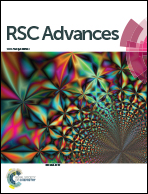Nanostructuring of nanoporous iron carbide spheres via thermal degradation of triple-shelled Prussian blue hollow spheres for oxygen reduction reaction†
Abstract
A template free strategy for designing hollow Prussian blue (PB) spheres with multi-shells is reported here. Small PB seeds were synthesized under optimized conditions using polyvinylpyrrolidone as a controlling agent. The large crystals grow from the smaller ones which have higher solubility. Voids gradually grow in the core of the large aggregates and the shell thickness increases owing to the outward diffusion of the solutes through the permeable shell leading to core–shell structure. Many shells could form at the surface of the core–shell structure through a step-by-step epitaxial crystal growth. A subsequent etching leads to the formation of triple-shelled PB hollow spheres. Likewise, a controlled thermal treatment under nitrogen yielded nanoporous iron carbide hollow spheres. The morphology is well-retained after the thermal treatment at 450 °C and completely destroyed at 700 °C because of the crystallization of the metal framework and the fusion of the pores. Nanoporous iron carbide demonstrates an efficient electrocatalytic activity for the oxygen reduction reaction. It shows a better durability than the commercial PtC-5% catalyst, with only 8% loss of the current density during the first 3500 s.



 Please wait while we load your content...
Please wait while we load your content...